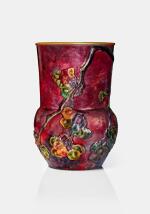Dreaming in Glass: Masterworks by Tiffany Studios
Dreaming in Glass: Masterworks by Tiffany Studios

Property from the Collection of Jeep and Carla Harned
Tiffany Studios
A Rare "Ginkgo" Vase
Auction Closed
December 8, 10:47 PM GMT
Estimate
40,000 - 60,000 USD
Lot Details
Description
Property from the Collection of Jeep and Carla Harned
Tiffany Studios
A Rare "Ginkgo" Vase
circa 1902
enameled copper
inscribed Louis C. Tiffany and impressed SG 35
7 1/4 in. (18.4 cm) high
Christie's New York, December 15, 1984, lot 513
Private Collection
Christie's New York, December 12, 1992, lot 551
Acquired from the above by the present owner
Private Collection
Christie's New York, December 12, 1992, lot 551
Acquired from the above by the present owner
Dekorative Kunst, vol. XI, 1902, p. 55 (for the present lot illustrated)
Janet Zapata, The Jewelry and Enamels of Louis Comfort Tiffany, London, 1993, p. 51 (for the present lot illustrated)
Janet Zapata, The Jewelry and Enamels of Louis Comfort Tiffany, London, 1993, p. 51 (for the present lot illustrated)
Louis Tiffany appreciated glass in all its multitude of characteristics and uses and was a genius for incorporating the material in an almost limitless variety of decorative applications. Enlisting the aid of Arthur J. Nash, the superintendent of his glasshouse, and Parker C. McIlhiney, his chief chemist, Tiffany was able to introduce a line of enamelware around 1899. They were first publicly displayed in the Tiffany Glass and Decorating Company’s exhibition at the 1900 Paris Exposition Universelle, where the company described them as “visions of delight.” The pieces featured both iridescent highlights and, more significantly, a unique translucency that allowed portions of the copper body to sparkle under reflected light. The incredible attention Tiffany’s enamelware received was only heightened when the Exposition awarded them the Grand Prix.
A similar display was shown by the firm at the 1901 Pan-American Exposition held in Buffalo, New York and caused one critic to proclaim: “The future extensive use of enamel seems to be assured, since experiments are now making, under the direction of Mr. Louis C. Tiffany, in his studio at Corona, Long Island, with the purpose of doing for enamel what has already been accomplished for glass. And surely all that ingenuity, skill and knowledge can suggest, this artist will work out and complete!”
Given the premier position at the entrance of the American exhibition at the 1902 International Modern Decorative Art exposition held at Turin, Italy, Tiffany decided to highlight his latest “mature works that show the shimmering enamel.” The vase offered here presents what is possibly the only design by Tiffany that features the gingko. It would have obvious appeal to his adoration of nature as well as his love of Asian art, where the tree symbolized various positive traits, including peace, hope and love.
This vase, with its gold and green serrated leaves, yellow, brown and red spherical berries, and sinuous branches in green-streaked navy, all in relief, against a slightly iridescent maroon ground, vibrantly displays all of the supreme creativity and technical command one hopes to find in Tiffany’s finest enamelware. The shape and form are fashioned flawlessly, and the actual enamels are applied as only a master craftsperson can. The products of Tiffany’s Enamel Department are as treasured today as they were when they originally appeared. This exhibition piece is indicative of the department’s primary tenet, as expressed by Elizabeth Willmarth, one of its first heads: “Nothing takes too long, costs too much or is too much trouble to produce.”
Paul Doros
A similar display was shown by the firm at the 1901 Pan-American Exposition held in Buffalo, New York and caused one critic to proclaim: “The future extensive use of enamel seems to be assured, since experiments are now making, under the direction of Mr. Louis C. Tiffany, in his studio at Corona, Long Island, with the purpose of doing for enamel what has already been accomplished for glass. And surely all that ingenuity, skill and knowledge can suggest, this artist will work out and complete!”
Given the premier position at the entrance of the American exhibition at the 1902 International Modern Decorative Art exposition held at Turin, Italy, Tiffany decided to highlight his latest “mature works that show the shimmering enamel.” The vase offered here presents what is possibly the only design by Tiffany that features the gingko. It would have obvious appeal to his adoration of nature as well as his love of Asian art, where the tree symbolized various positive traits, including peace, hope and love.
This vase, with its gold and green serrated leaves, yellow, brown and red spherical berries, and sinuous branches in green-streaked navy, all in relief, against a slightly iridescent maroon ground, vibrantly displays all of the supreme creativity and technical command one hopes to find in Tiffany’s finest enamelware. The shape and form are fashioned flawlessly, and the actual enamels are applied as only a master craftsperson can. The products of Tiffany’s Enamel Department are as treasured today as they were when they originally appeared. This exhibition piece is indicative of the department’s primary tenet, as expressed by Elizabeth Willmarth, one of its first heads: “Nothing takes too long, costs too much or is too much trouble to produce.”
Paul Doros
